Free Audio Guide: A Walk through Bremen's Historic City Centre
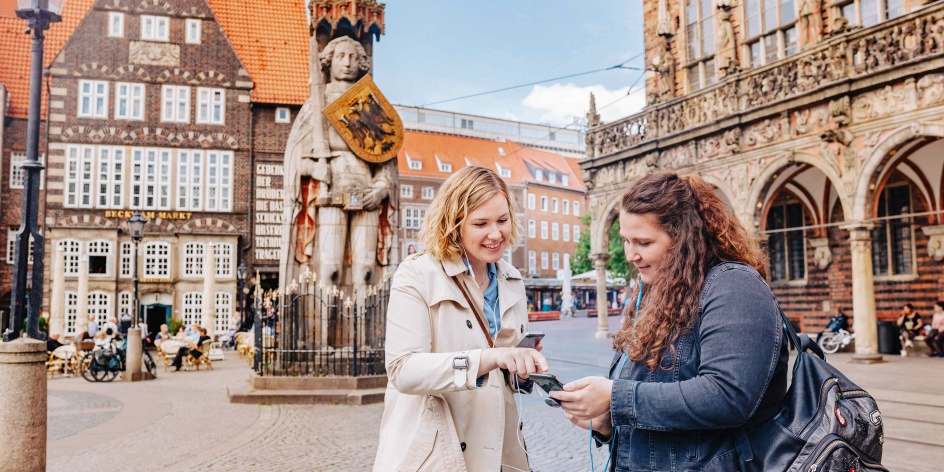
© WFB / Jonas Ginter
Discover Bremen's rich history with our audio guide! Explore the city at your own pace with this self-guided tour. Immerse yourself in fascinating places and stories as you follow the itinerary, which lasts approximately 1.5 to 2 hours. Start your journey now!
Station 1: Welcome to Bremen
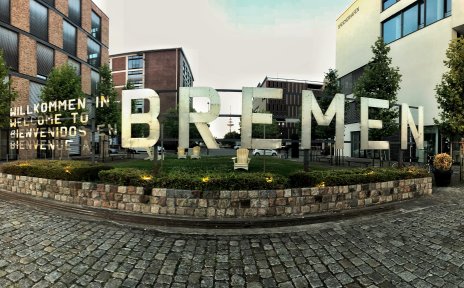
Station 1: Location
You can start the audio guide wherever you like. However, it would be practical to start near the market square.
Audio length: 02:26 min
Station 1: Transcript
Station 1: Welcome to Bremen
We welcome you to Bremen, the over 1,200-year-old Hanseatic city on the River Weser. History, exciting museums, science centres and diverse cultural activities await you in Bremen.
We are delighted to have you in our traditional and cosmopolitan city.
On our audio walk through Bremen's historic city centre, you will walk along the so called Nagelroute. You can recognise it by the silver and bronze-coloured metal pins in the pavement. Along the way, you will get to know some of Bremen's sights and receive tips for other attractions and activities.
Let's start our tour of the city with a few details about Bremen:
Together, the twin cities Bremen and Bremerhaven form the smallest German federal state, which also goes by the name of Bremen. The city of Bremen is characterised by tradition and cosmopolitanism. It is not only around the market square that it offers historical treasures. However, Bremen is also a modern city with an unmistakable charm. Science centres such as Universum Bremen and botanika invite you to experience science up close. The diverse cultural life of this traditionally independent City also offers something for all tastes: The Theater Bremen, the shakespeare company, the Metropoltheater as well as the many museums - such as the Überseemuseum, the Kunsthalle or the Weserburg, one of Germany's first collector's museums for modern art. Bremen was also named ‘City of Literature’ by UNESCO in 2023.
Bremen's most important economic sectors are the automotive industry, aerospace technology, logistics, electrical and mechanical engineering as well as the food and beverage industry. You can also look into these fields, for example during a factory tour at Mercedes or a Beck’s brewery tour.
As of 2024, Bremen is the eleventh largest city in Germany and has a population of around 570,000 people. It stretches around 38 kilometres along both sides of the Weser, reaching 16 kilometres at its widest point. This means that Bremen has the lowest population density of all major German cities.
Now, our tour will lead us to the market square, a central spot rich in Bremen’s history, where we’ll begin our journey through the city’s past. Please head to the front of the building Deutsches Haus also called Beck's am Markt.
Station 2: The History of Bremen
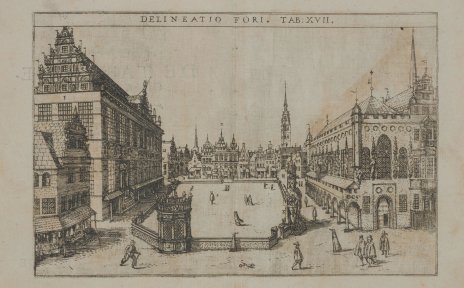
Station 2: Location
You find yourself on the market square in front of Beck's am Markt also called Deutsche Haus.
Audio length: 03:12 min
Station 2: Transcript
Station 2: The History of Bremen
You find yourself on the market square in front of Beck's am Markt also called Deutsche Haus.
Bremen was first mentioned in a written document in 782 A.D. However, there is a legend surrounding the city's origins. It is rumoured that homeless fishermen looking for a place to stay discovered a mother hen with her chicks on a dune on the Weser. Once they decided that it couldn't be all that bad where chickens felt at home, they settled in the dunes with their families. According to legend, these were Bremen's first settlers. If you look closely, you can also find the hen on the façade of the town hall.
Since its beginnings, the quest for independence has been central to Bremen's history:
In 787, Bremen became a bishop's seat under Charlemagne. Around two hundred years later, Emperor Otto I conferred market rights upon the city, allowing urban trade to develop. The settlement became a town. In order to secure trade, Bremen joined the Hanseatic League in 1358 - the powerful alliance of cities that stretched from Flanders all the way to the Baltic region. Finally with the granting of ‘Imperial Freedom’ as part of the Linz Diploma in 1646, Bremen's independence was secured under constitutional law. It was henceforth a Free Imperial City.
With the dissolution of the Holy Roman Empire of the German Nation in 1806, Bremen became an independent, sovereign state and was henceforth known as the Free Hanseatic City of Bremen. Yet as early as 1810, the city was taken over by the French Empire in the course of Napoleon's conquests and became the capital of the department of the Weser estuaries. Only five years later, thanks to the efforts of Johann Smidt at the Congress of Vienna, the Hanseatic city became a sovereign member of the German Confederation. In that very same century, the city became a federal state with the founding of the German Empire in 1871. However, in 1934 Bremen lost its status as a state under the Nazi regime. Together with Oldenburg, it was placed under the control of a governor. During air raids in the Second World War, around 62% of the city were destroyed. After the Allied occupation in 1945, the Hanseatic city was finally re-established as an independent federal state together with Bremerhaven in 1947.
In front of you is the ‘Deutsche Haus’. You can recognise it by the inscription which translates to: ‘Remember the brothers who bear the fate of our separation’. These words by Wilhelm Kaisen have adorned the façade of the building since 1955 and are reminiscent of the German Division. After being destroyed in the war, corner building was rebuilt in 1951 as the ‘Rathscafé’ using fragments of old houses from the historic city centre. The sandstone reliefs thematise destruction and reconstruction.
Now please go to the centre of the market square so that you can clearly see the Hanseatic cross on the pavement.
Station 3: Bremen's Market Square
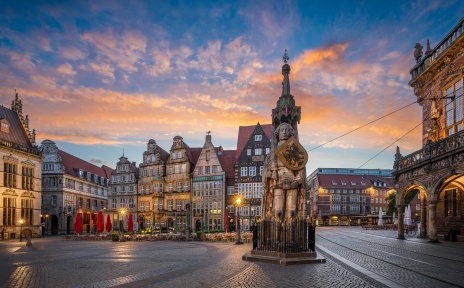
Station 3: Location
You find yourself in the centre of the market square, looking at the Hanseatic cross on the pavement.
Audio length: 02:53 min
Station 3: Transcript
Station 3: Bremen's Market Square
You find yourself in the centre of the market square, looking at the Hanseatic cross at the bottom of the pavement.
Also known as the ‘gute Stube’ meaning ‘parlour’, the market square forms the heart of the city. According to legend, Bremen was founded here. Numerous fragments of Bremen's history can be found around the market square.
From an early medieval trading centre, the market square has developed into the work of architectural art that it is today. It has always been a people's place. Crowds gathered here to protest, trade or defend themselves. Until the 18th century the market square was the centre of public life: the town bailiff, an overseer and administrator of sorts, held his court here under the arcades, resolutions and laws were passed by the council court, and even death sentences were proclaimed from the balcony of the town hall. Big victories were also celebrated on the market square, such as after the Thirty Years' War, the victory over Napoleon or the regaining of freedom in 1814. To this day, fans celebrate the titles won by their football club Werder Bremen on the market square.
Do you see the pattern incorporated in the centre of the pavement of the market square? In the centre of a wheel with ten spokes you can see the Hanseatic cross. This was donated by the Hanseatic League as a reminder of Bremen’s participation in the wars of liberation against Napoleon. If you can't spot the cross, it is probably being covered by the set-up of an event.
Known as one of the most beautiful squares in Europe, Bremen’s market square is known to attract many people. When the weather allows, you can watch the hustle and bustle from the outdoor area of the neighbouring cafés while enjoying a delicious piece of cake. You might also find an event taking place here, such as at the La Strada street arts festival, the Christmas market, the small Freimarkt or the Musikfest, during which the market square shines in festive splendour.
Now take a look at the buildings next to Beck's am Markt. Pay particular attention to the corner building on the left and the pharmacy next to it. After they were destroyed in the Second World War, the buildings were remodelled and rebuilt. Hidden behind the rococo façade of the left house is a modern building that was covered with the walls of a town house from the banks of the Weser in 1958. The façade of the Rathsapotheke also has an interesting history. Its elaborate neo-Renaissance decorations are the result of a competition to beautify the cityscape in the 19th century.
Now turn your gaze back to the right - behind the tram tracks you will spot the biggest gem of the market square: the magnificent, over 600-year-old town hall! Find out more about this impressive sight at the next stop.
Station 4: The Bremen Town Hall
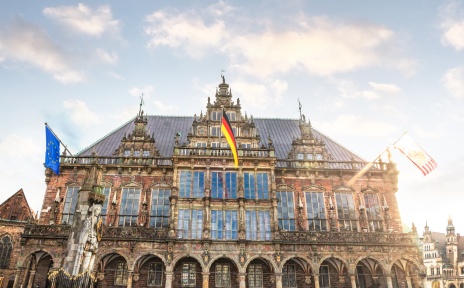
Station 4: Location
You find yourself in the centre of the market square looking towards the town hall.
Audio length: 03:28 min
Station 4: Transcript
Station 4: The Bremen Town Hall
You find yourself in the centre of the market square looking towards the town hall.
As one of the most beautiful town halls in Germany, the ensemble of the Old and New Town Hall, together with the Roland statue directly opposite, were designated a UNESCO World Heritage Site in 2004. It is an extraordinary example of a late medieval town hall and symbolises the municipal freedom of the city republic. UNESCO emphasised in its statement: ‘The town hall and the Roland in Bremen are a unique testimony to civic autonomy and sovereignty as they developed in the Holy Roman Empire’. The outstanding façade is also explicitly highlighted in the explanatory statement.
Built between 1405 and 1410 as a market and council hall in the Gothic style, the town hall is Bremen's most important building. However, it has only had its current appearance since 1612. In this year, the Bremen master builder Lüder von Bentheim gave the town hall an ornate façade in the Weser Renaissance style, modelled after Dutch designs.
The eight monumental sculptures on the market façade are particularly noteworthy. Take a look at the larger-than-life figures. On the left you can recognise the emperor and next to him the seven electors. They symbolise Bremen's claim to imperial freedom and thus the city's independence from the church.
But what is hidden inside the town hall? The two storeys of the old town hall each consist of a large hall, the ‘Lower’ and the ‘Upper Hall’. The town council used to meet in the upper hall, passing resolutions, making politics and dispensing justice to the citizens. Today, the Upper Hall with its magnificent ‘Golden Chamber’, is used for representative purposes. It is richly decorated with murals, decorative portals and wood carvings. This is why it is considered Bremen's most beautiful ballroom. In 1905, the painter Heinrich Vogeler from Worpswede designed the Güldenkammer using the Art Nouveau style incorporating various nature motifs.
The Lower Hall has been preserved almost unchanged and is one of the most beautiful German secular Gothic buildings: The three-aisled hall has an ornate Gothic portal to the east and west and is supported by octagonal oak pillars. Originally used for markets and theatre performances, it now hosts temporary exhibitions.
When you walk towards the cathedral later, you will spot the New Town Hall behind the old one. The architect Gabriel von Seidl harmoniously added it to the old building as an extension at the beginning of the 20th century following the neo-Renaissance style. In the New Town Hall, for example, you can admire the 'Tapestry Room', which was named after a large French tapestry from the 17th century and was originally intended as the mayor's room. Today, the room is used as a small reception and consultation room as well as for civil weddings.
The town hall is also the official residence of the mayor of Bremen. Whoever holds this office is also the Prime Minister of the state. Every week, the Bremen state government meets here in the Senate Hall.
If you like to learn more about the Town Hall, you might also take part in a guided tour.
Now go to the Roland statue and start the audio file for the next stop please.
Station 5: Bremen's Roland Statue
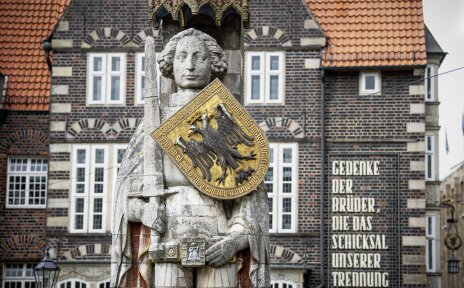
Station 5: Location
You find yourself on the market square looking at the statue of Roland.
Audio length: 05:30 min
Sation 5: Transcript
Station 5: Bremen's Roland Statue
You find yourself on the market square looking at the statue of Roland.
Law and municipal independence: nothing epitomises Bremen's striving for these more than the Roland. The landmark is one of the oldest statues in Germany that is still in its original location. There were a total of 55 Roland statues in Europe, 20 of which have been preserved. Although Bremen's Roland is not the only one, it is the oldest, most representative, most famous and, at 5.5 metres, also the tallest of the German statues. With his pedestal and canopy, he even measures 10.21 metres. He too is a UNESCO cultural heritage site.
But who was Roland actually? Little is known about his historical persona. Yet he is the subject of the Roland legend, which has its literary origins in the old French text ‘La Chanson de Roland’ from 1100. Central to the significance of the Bremen statue is Roland's connection to Charlemagne and thus the emphasis on worldliness as opposed to religion.
After the archbishop's mercenaries burnt down the first Roland statue, which was still made of wood, in 1366, the Bremen council had the Roland built from limestone in 1404. In this way, they symbolised the right of the Bremen patricians to rule the city.
Now take a closer look at the Roland: The young knight is dressed entirely in the fashion of the 1400s, with a tight leather jerkin over chain mail, a heavy link belt, armoured knees, splinted legs and long, wavy hair. He wears a coat of arms with the double-headed imperial eagle. The inscription, translated from old German, reads: ‘Freedom I proclaim to you, which Charlemagne and many other princes have truly given to this city. Thank God for this, this is my advice.’ The naked sword in Roland's hand is a symbol of justice. His long hair symbolises a free man, but above all a knight and thus the ideal of the time.
Roland smiles proudly in the direction of the cathedral, the archbishop's official residence, who at the time laid claim to the secular rule over Bremen. Allegedly, Roland’s challenging gaze was intended to show the archbishop: The people of Bremen would no longer listen to him. After all, according to the inscription on his shield, Emperor Charlemagne had already promised them freedom. This interpretation sounds plausible, but does not necessarily correspond to the historical facts.
Another theory is that Roland is looking towards Hamburg to greet the merchants coming from the Hanseatic city with imperial freedom and market rights.
Beyond its symbolic value, Roland had a practical use: The distance between the statue's pointed knees is around 55 centimetres. This equals the historical length of the Bremen cubit. The distance between the knees is said to have been used to measure fabric in earlier times.
Have you spotted the little man between Roland's feet? Well, there's a legend about him too: Countess Emma von Lesum, who was known for her piety and charity, wanted to give the people of Bremen a pasture. As a measure, she chose the area that a man could circle in one hour. Duke Benno, her brother-in-law and heir, chose a man without legs for the measuring march in the hope of losing only a small amount of land. Contrary to expectations, this beggar, whom you see at the foot of Roland, crawled round a large area - the Bürgerweide. The northern part of this meadow was turned into the Bürgerpark in 1866, which today serves as a green oasis for recreation. As the park is one of the few almost completely preserved horticultural creations of the 19th century, it is considered one of the most important landscape parks in Germany.
To prevent the Roland from being damaged, it was fenced off. To protect the statue, a wall was built around it, allowing it to survive even the bombings of World War II unharmed. Rumour has it that the people of Bremen also store a replacement in the basement of the town hall in case of an emergency. Only the mayor supposedly knows where the emergency Roland is hidden. You'll have to decide for yourself whether that's true ...
A major intervention in the history of Bremen's landmark was the replacement of the head in 1983 in response to air pollution, which had caused considerable damage to the statue. His original head can be viewed in the Focke Museum.
Roland has always been the guardian and a landmark of Bremen. According to legend, the city will not fall as long as Roland stands.
If you turn around, your gaze will be drawn directly to a strikingly modern building - the Haus der Bremischen Bürgerschaft. Before you find out more about this parliament building at the next stop, take a short walk to the Bremer Loch, a manhole cover in the pavement of the market square. It is located to the left of the parliament building. If you drop a coin into the slot, you will hear the sounds of the Bremen Town Musicians. The money will be donated to the Wilhelm Kaisen Bürgerhilfe charity. A little behind the Bremer Loch in the direction of the cathedral, you can also see and touch a bronze model of Bremen's historic city centre. Places and buildings are labelled in Braille, among letters.
For the next stop, find a place on the market square with a good view of the Haus der Bürgerschaft.
Station 6: Bremen’s Parliament
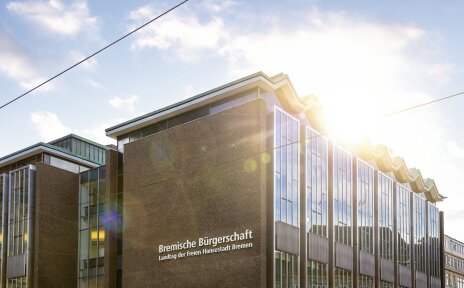
Station 6: Location
You find yourself on the market square looking at the front side of the Bürgerschaft.
Audio length: 02:01 min
Station 6: Transcript
Station 6: Bremen’s Parliament
You find yourself on the market square looking at the front side of the Bürgerschaft.
The Haus der Bürgerschaft: here the parliament of the federal state of Bremen - known as the Bürgerschaft - and the Bremen city parliament hold their meetings. At the Bürgerschaft sittings, members of parliament from Bremen and Bremerhaven come together. The Bürgerschaft building is also the official residence of the state's first person - the Bürgerschaftspräsident or Bürgerschaftspräsidentin. This is where debates take place, majorities are fought over, motions are tabled and laws are passed.
However, the outside of the listed building has something to offer as well: Modern architecture in the midst of historic buildings. Completed in 1966 by the internationally acclaimed architect Wassili Luckhardt, it was seen as extremely controversial at the time of its construction. With its extensive use of glass, aluminium and dark clinker bricks in the style of the 1960s, this glass parliament forms a respectful counterpart to the town hall. The Berlin sculptor Bernhard Heiliger supplied the cast aluminium window reliefs. Furthermore, he used bronze to decorate the glazed exterior.
Before the Haus der Bürgerschaft was built here, this site was occupied by the ‘Börse’ building, which was badly damaged in the Second World War and later demolished. The semi-circular staircase of this representative building can still be found behind the Haus der Bürgerschaft.
The Bürgerschaft also includes the sculpture garden. Here you can view six works by Gerhard Marcks for free during opening hours. You will find the entrance on the market side to the right of the Bürgerschaft.
Before we continue the tour, you will learn about one last important historical building in the market square. You will find it on the opposite side of the town hall, to the right of the entrance to Böttcherstraße. Find a spot in front of this building before you start the next station.
Station 7: The Schütting
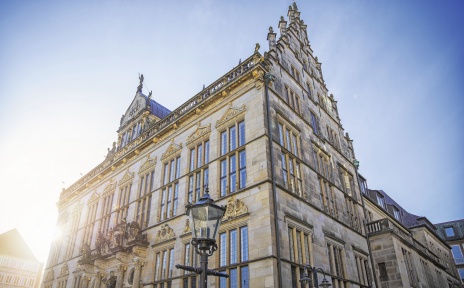
Station 7: Location
You find yourself on the market square in front of the Schütting.
Audio length: 02:32 min
Station 7: Transcript
Station 7: The Schütting
You find yourself on the market square in front of the Schütting.
Right now you are looking at the building which today houses the Chamber of Commerce and is called Schütting. But what does Schütting actually mean? There are several theories. One sees the origin of the word in the Norwegian ‘Skotting’, which refers to meeting houses. Johann Heinrich Dreyer, once mayor of Lübeck, derived it from the verb ‘schütten’ meaning ‘to pour’, as the financial resources of merchants are ‘poured together’. The last variant derives the word from ‘Schossen’, which meant to raise taxes.
Regardless of what its name means, the Schütting was erected between 1537 and 1538 as a guild house for the Bremen merchants by the Antwerp master builder Johann den Buschener. Imitating the Renaissance buildings of Flanders, it is a magnificent counterpart to the town hall and emphasises the status and prosperity of the merchants in Bremen.
The late Gothic west gable has been preserved in its original form. The east gable, on the other hand, is a fine example of the early Renaissance in Bremen. The market front you are looking at was remodelled in 1594 with elements of the Weser Renaissance. Since then, there have been repeated changes, like the magnificent neo-baroque portal with an open staircase, which was only added in the 19th century. During the Second World War, the Schütting burnt down to its outer walls, was rebuilt within and reopened in 1951.
Above the portal you can read the famous quote by Bremen's mayor, writer and journalist Otto Gildemeister: ‘Buten un binnen/ Wagen un winnen’. The literal translation is: ‘ Without and within - dare and win’. This summarises the venture, risk and profit of Bremen's trade at home ‘binnen’ and overseas ‘buten’. Above the lower windows you can see the coats of arms of the Hanseatic cities of Hamburg and Lübeck and the Hanseatic trading centres of Bergen, Bruges, London and Novgorod.
Another interesting fact especially for coffee enthusiasts is that in 1673 the first coffee house in the German-speaking world opened in the Schütting.
Now follow the Nagelroute, which runs along the left side of the Schütting, and walk towards the entrance of Böttcherstraße until you have a good view of the golden relief above.
Station 8: The Böttcherstraße
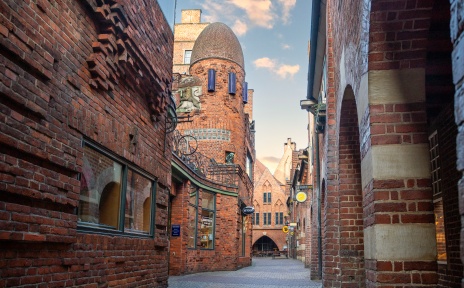
Station 8: Location
You find yourself in front of the golden relief at the entrance to Böttcherstraße.
Audio length: 06:19 min
Station 8: Transcript
Station 8: The Böttcherstraße
You find yourself in front of the golden relief at the entrance to Böttcherstraße.
The 108 metre long street was once the alley of the barrel makers. In the Middle Ages, it provided an important connection between the market square and the Weser. When the harbour and all its suppliers were relocated in the middle of the 19th century, Böttcherstraße began to decline.
From 1922 to 1931, the coffee manufacturer Ludwig Roselius had the street rebuilt and remodelled into an architectural work of art. He wanted to show Germany's cultural rebirth after the defeat of the First World War. A key aspect of the design was the link between tradition and modernity.
Can you see the gilded relief above the entrance to Böttcherstrasse? The artwork ‘Der Lichtbringer’ which means 'The Bringer of Light' by the Worpswede sculptor Bernhard Hoetger was not installed until 1936. As the street and its architecture, and in particular the abstract brick relief above the entrance, which is no longer visible today, had been criticised by the Nazis, Hoetger an Roselius tried to appease them with this work. What at first glance could be interpreted as a battle between the archangel Michael and the dragon of hell also has parallels to the Saga of the Nibelungsand was interpreted as a Führer metaphor during the Nazi era. Which is why it has to be viewed critically and is regularly discussed.
Before you go any further, look up at the building in front of you on the right-hand side. High up on the gable, you can recognise the sandstone statues of the ‘sieben Faulen’ meaning ‘The Seven Lazy Men’. These are figures from a well-known legend by the Bremen writer Friedrich Wagenfeld. According to the legend, there were once seven brothers in Bremen who were so lazy that they didn't want to fetch water from the Weser. So, they built a well and laid pipes. They also didn't feel like pulling carts out of the mud or going into the forest to collect wood, so they paved roads and planted trees. Whether this is laziness or innovation is for you to decide.
Now walk along the street until you discover the Paula Modersohn-Becker Museum on the left-hand side.
You stand before one of the first museums in the world to be dedicated to the work of a female artist. Paintings from all creative phases of what is probably Germany's most famous female painter testify to her outstanding status as a pioneer of modern painting around 1900.
Please walk a few steps further along Böttcherstraße into the neighbouring courtyard on the left.
You are now in the Handwerkerhof. Here you can admire two further works of art by Hoetger: a bust of Ludwig Roselius, a Bremen coffee merchant and inventor of the first decaffeinated coffee, ‘Kaffee HAG’, and also a fountain of the ‘Sieben Faulen’, who are depicted here again. Atop this fountain, you can as well discover the Bremen Town Musicians. For once, the animals are not in a stacked formation, but rather walking one after the other on their way to Bremen. Perhaps not all the animals are on site. Unfortunately, they are often misunderstood as souvenirs.
Now walk out of the courtyard and follow the Nagelroute to the Bremen also Tourist Information.
Do you hear bells? Then you're in luck: since 1934, 30 Meissen porcelain bells are ringing out a melody several times a day. The exact schedule can be found on the information board at the carillon house in front of you. At the same time, you can see ten carved and colourfully painted wooden panels by Hoetger on the neighbouring tower, depicting stories of Atlantic crossings. The focus is on personalities such as Leif Ericson, Christopher Columbus, Count Zeppelin and the crew of the ‘Bremen’, the first aircraft to cross the Atlantic non-stop in an east-west direction. Incidentally, you can marvel at the original Junkers W33 aircraft at the Bremen Airport.
In the carillon house on the ground floor you will find the Bremen Information. The staff will be happy to help you with any questions regarding your stay in Bremen. Please continue your tour and walk along Böttcherstraße until you reach the aquariums on the right-hand side.
As part of the remodelling of the street, each of the seven houses was given its own name. The main architects were Alfred Runge, Eduard Scotland and Bernhard Hoetger. The latter created the traditional brick architecture of the passage with Art Nouveau and Art Deco elements. He designed the Paula Modersohn Becker House and the Atlantis House, which today houses the Radisson Blu Hotel and the impressive blue and white Himmelssaal. Opposite is the Robinson Crusoe House, named after Daniel Dafoe's novel hero. In the story, he is the son of a Bremen merchant - proof of the English writer's attachment to the city of Bremen.
Heavily damaged during the Second World War, the facades of Böttcherstrasse were largely rebuilt by 1954 with funds from the Kaffee-HAG group. From the 1970s onwards, damage to the buildings fabric became apparent again. In 1988 Sparkasse Bremen bank acquired Böttcherstrasse and in the course of a refurbishment programme up to 1999 restored it as far as possible to its original pre-war condition. Since 2003, Böttcherstrasse has been owned by the ‘Bremen Sparer-Dank’ foundation, which to this day preserves and promotes the original basic idea of combining art and craftsmanship.
These days, Böttcherstraße is an artisan's paradise with small shops, restaurants, museums and workshops. The Böttcherstraße art collections include the museum in the Roselius House and the Paula Modersohn-Becker Museum and form the architectural and cultural highlight of the passage.
Please follow the markings through the pedestrian subway to the promenade along the Weser. Please watch out for bicycle traffic here. At the promenade you'll see a jetty, the so-called Martinianleger. Walk to the benches on its right.
Station 9: The Martinianleger and St. Martin's Church
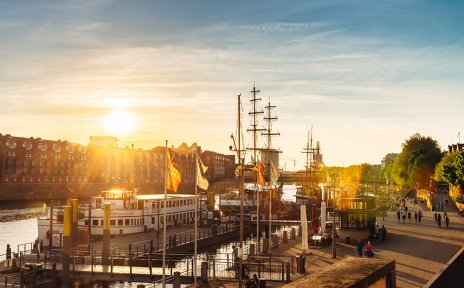
Station 9: Location
You find yourself on the Weser promenade Schlachte at the ‘Martinianleger’ jetty.
Audio length: 01:39 min
Station 9: Transcript
Station 9: The Martinianleger and St. Martin's Church
You find yourself on the Weser promenade Schlachte at the ‘Martinianleger’ jetty.
The Martinianleger below St. Martin's Church is the landing site for passenger and excursion boats on the Weser promenade. Take a Weser and harbour cruise on historic or modern ships from here and get to know Bremen's maritime side. You can even travel to Vegesack or further downstream to Bremerhaven. The twin city of Bremen is only 60 kilometres away.
Turn around now. Opposite the Weser rises the historic Protestant St Martin's Church, which gave the jetty its name. It is the smallest, youngest and also the most picturesque of the four historic parish churches in Bremen and was initially built around 1229 as a three-aisled basilica. In the 14th century, it was extended into a hall church.
Around two centuries later, a rectory was added - the Neanderhaus. It was named after Joachim Neander, who lived in the house and wrote the famous hymn ‘Praise to the Lord, the Almighty’. In fact, Neander also gave his name to the prehistoric man who was later found in the Neandertal valley which was named after him.
The late Gothic brick building was badly destroyed in the Second World War, but was rebuilt after the war.
You can now relax a little by the Weser. Perhaps take a seat on one of the benches. Enjoy the maritime flair in the traditional harbour and trading city of Bremen! At the next stop, we'll tell you something about life on the river and the Schlachte Weser promenade.
Station 10: The Schlachte
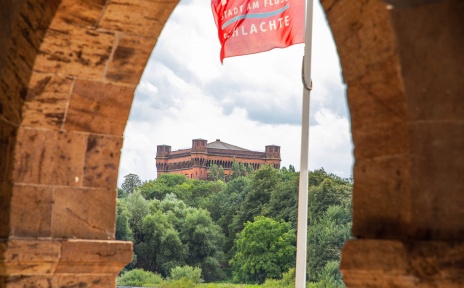
Station 10: Location
You find yourself on the Weser promenade Schlachte.
Audio length: 05:35 min
Station 10: Transcript
Station 10: The Schlachte
You find yourself on the Weser promenade Schlachte.
This is Bremen's Weser promenade - the Schlachte. But what exactly does Schlachte mean and does the name have anything to do with "schlachten" the German word for ‘slaughter’? No, the term is derived from the Low German word ‘slait’, which means ‘to hammer’ and goes back to the fact that posts were used to fortify the banks here. The Schlachte was first mentioned in 1250, when the shore of the Weser was already fortified with piles and wattle.
It is assumed that the Schlachte was Bremen's main harbour from around the year 1200. However, the natural silting of the Weser and the greater draught of the ships resulted in larger vessels no longer being able to navigate to the Schlachte as early as the 16th century. Therefore, the Bremen council decided to build an alternative harbour in the north of Bremen. The Vegesack harbour was completed in 1623 by the master builder Jacob Clausen, making it one of the first artificial seaports on German soil. Its prime lasted until around 1820, when larger ships were also no longer able to reach Vegesack due to silting. This made it necessary to establish another harbour. In 1827, the mayor Johann Smidt bought a piece of land in Lower Saxony to build a harbour at the mouth of the Weser. There, a promising seaport developed - today's city of Bremerhaven. In this way, Smidt gave Bremen free access to the sea.
Small roads used to lead from the old city centre to the Schlachte - the so- called Schlachtpforten. The Schlachte was located outside the city walls and could only be reached through these passages. Today, the Schlachtpforten are still preserved as street names.
As part of Expo 2000 with the motto ‘Man-Nature-Technology’, the reconstruction and redesign of the Schlachte began. The people of Bremen rediscovered their ‘City by the River’. Today, the Schlachte is a vibrant centre of city life. Whether watching ships, strolling, enjoying or partying: from the terraces and beer gardens of a diverse international gastronomy, you can enjoy the view of the water and the historic and modern ships, especially when it's sunny.
Have you already discovered the ships on the Schlachte? Right next to the three-master ‘Admiral Nelson’, a rustic pirate-style pancake restaurant anchored directly opposite St Martin's Church, you will find the Alexander von Humboldt, known worldwide from the Beck's commercials. You might remember the smoky sung ‘Sail away’ by Joe Cocker. Her striking green sails have been the Bremen brewery's flagship for many years. The ship has now found its final home port in Bremen and serves as a restaurant and hotel ship.
There is always something happening at the Schlachte. In the summer season, you can rummage for treasures at the Kajenmarkt, enjoy live music and get refreshments at various food stalls. In the Christmas season, the Schlachte-Zauber - a medieval Christmas market - awaits you.
Continue walking up the Weser to the left of the river now. At the staircase behind the bridge, you will pass the ‘Memorial to the mass robbery of European Jews by the Nazi regime and the involvement of Bremen companies, authorities and citizens’ also known as the ‘Aryanisation’ memorial. Through a window you can see shadowy furniture. It serves as a reminder of the National Socialists' “Aktion M”, in which furniture was confiscated from the homes of Jews who had fled or been deported.
Next, you pass the theatre ship and the arcades. The latter have been undergoing refurbishment since 2020 due to their historical significance. As medieval and early modern bank fortifications came to light during the work, archaeological excavations began here. Among other things, medieval pilgrimage signs, parts of scales, pieces of imported clay vessels, silver coins, seal stamps, daggers, fishhooks and a fish trap were found. Among other things, these finds have been used for historical research. The arcades themselves are listed buildings and probably date back to the 17th century. They acquired their current appearance in 1913 and represent a relic of the inner-city inland waterway dock of the imperial era.
Across the Weser, you can see the building of the German Maritime Search and Rescue Service, also DGzRS, which has its headquarters here in Bremen. The DGzRS was founded in 1865, is financed by donations and is responsible for coordinating sea rescues in the North and Baltic Sea.
Right next to it is the so-called ‘umgedrehte Kommode’ which translates to upside-down wardrobe. You can recognise it by its distinctive shape with the small towers. The historic water tower, which is over 100 years old, used to ensure the water pressure in Bremen.
Keep following the markings in the pavement. You are about to leave the Weser. Cross the pedestrian subway and go up the stairs on the right. Now walk along the road for a short distance. Then turn left into the street ‘Hinter der Holzpforte’. Pass the statue of the famous Bremen artist Heini Holtenbeen and walk into the alley between the ‘Komödie Bremen’ theatre and the ‘Teestübchen’ café until you reach a narrow square.
Station 11: The Schnoor
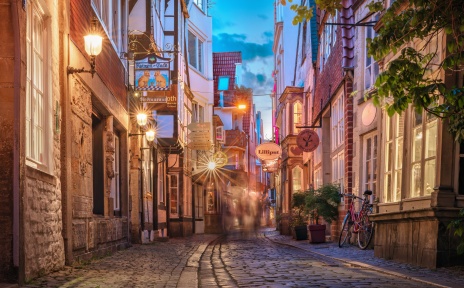
Station 11: Location
You find yourself on the Wüstestätte square.
Audio length: 04:46 min
Station 11: Transcript
Station 11: The Schnoor
You find yourself on the Wüstestätte square.
By now you have arrived in Bremen's oldest preserved district, the Schnoor. In 1959, this area was the first large ensemble in Germany to be declared a protected architectural monument.
The square you are currently standing on is called the ‘Wüstestätte’, meaning 'desolate place'. It commemorates that this area lay bare after a fire in the 17th century.
The Bremer Geschichtenhaus awaits you on your left. There you can immerse yourself in the history of our Hanseatic city with all your senses. Actors dressed as historical Bremen celebrities will take you back in time. However, the experience is only offered in German.
If you continue along the Nagelroute through the narrow alley, you will see the wedding house on the right-hand side at number 5. In the Middle Ages, couples who came to Bremen from the countryside were only allowed to marry in the city cathedral if they could prove that they lived here. For this purpose, there were wedding houses. The green half-timbered house is based on this tradition and, with a total of 43 square metres, it is one of the smallest hotels in the world.
By the way, even if you don't want to get married, you can book the cosy wedding house for up to 2 people. You can relax here on three small floors with your own whirlpool and four-poster bed right under the roof.
Continue along the narrow alley and turn left into the street ‘Schnoor’. Follow the markings until you reach a small square while you continue listening.
Take your time to look around and soak up the picturesque ambience. This street has given its name to Bremen's smallest district. But what does ‘Schnnor’ actually mean? Take a close look at the houses. Does the row of buildings remind you of anything? Schnoor is Low German and means ‘Schnur’ which translates as 'string'. The district is named lie this because the small and lovingly restored houses from the 15th and 16th centuries are lined up like pearls on a string. They follow the course of the Balge, a former branch of the Weser.
You now find yourself on a small square. The Stavendamm was named after medieval bathing parlours. A fountain in the centre is particularly reminiscent of the bathhouses. However, men and women not only washed here, they also used it as a place for indecent and sometimes immoral activities.
Continue past the Hartke Haus to the next street. Stop here for the time being. You have the best view on the opposite side of the road. If you cross the road, please pay attention to the traffic.
In Kolpingstraße on the right-hand side, you will see a relatively new orange-coloured building complex: this is the Birgitten Monastery including a guest house, a retreat area and a chapel. It was built between 2001 and 2002 as the first new monastery building in Bremen since the Middle Ages and consists of three interconnected structures.
Now follow the route along the ‘Lange Wieren’ road and stop at the church on your left.
In front of you, you will discover St John's Church, built by the Franciscans in the 14th century. It is the only Catholic church in the centre of Bremen and also houses a public school. However, Bremen is traditionally Protestant in character. Note the simple design and the two corner towers of the church, which rise up instead of one prominent steeple. The church was originally used as a monastery church of the Franciscan order. Following various changes of use, it has been used as a Catholic church again since 1823. If you find time to visit the interior of the Gothic hall church, you will also find a modern and simple design.
You are now leaving the Schnoor. To do so, you can follow the markings and use the stairs. If you prefer to avoid the stairs, there is an alternative: Along this route, you will also find the memorial to the victims of the November 1938 progroms. Walk back along ‘Lange Wieren’, then turn left at ‘Am Landherrnamt’. You will find the memorial at the junction with ‘Dechanatstraße’. Next, head left to return to the Nagelroute.
You will then reach the Domsheide public transport hub. Please cross the road and tracks carefully. Watch out for traffic. Follow the route in the direction of the fast food restaurant. As soon as you turn the corner, you will see the cathedral. Cross the tram tracks carefully.
When you reach the cathedral, find a suitable place in front of the steps. Watch out for cyclists here too.
Station 12: St Peter's Cathedral
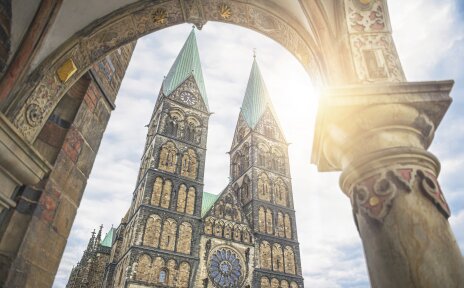
Station 12: Location
You find yourself in front of St Peter's Cathedral.
Audio length: 04:37 min
Station 12: Transcript
Station 12: St Peter's Cathedral
You find yourself in front of St Peter's Cathedral.
1,200 years of history await you in the magnificent St Peter's Cathedral. Here - on the highest natural elevation of a dune range, roughly ten metres above sea level - is the place where the diocese of Bremen was founded.
Now please take a look at the statues on the front of the cathedral. In the centre you will find Emperor Charlemagne holding a model of the cathedral. To his right you can see the cathedral's namesake and patron saint - the holy apostle St Peter. He is holding the key to the kingdom of heaven. Which, interestingly, is also the main component of Bremen's coat of arms.
As it towers before you now, the cathedral did not always look like this. In 789, a wooden church was built here, which was replaced by a stone building in 805. After repeated destruction and reconstruction, a Romanesque cathedral in the form of a three-aisled pillar basilica with two crypts was built in the 11th century. This created the basic structure of today's church.
Have a look up the mighty 98 metre high towers.
The double tower front was not built until the 13th century. This gave the cathedral its early Gothic character. In return for a small entrance fee, you can climb the 265 steps of the south tower. Around 1500, the cathedral was finally converted into a late Gothic church with delicate net arches.
But how did the cathedral become Protestant? The first Reformation sermon was preached in Bremen in 1522. Just three years later, Catholic masses were banned.
In 1648, after the Thirty Years' War, Protestant Sweden annexed the diocese of Bremen, and so the cathedral and the former cathedral immunity became Swedish, later Hanoverian. It was not until 1803 that the cathedral area fell back to the city of Bremen.
For almost the entire 19th century, the cathedral remained neglected. The south tower collapsed in 1638. This left the cathedral with only one tower for around 250 years. It was not until 1888 that extensive restoration work began, both beautifying and altering the historic appearance, based on the ideas of cathedral architect Max Salzmann. During the Second World War, the cathedral was barely hit by bombs and was already restored in 1950.
In the 1970s, when underfloor heating was supposed to be installed, numerous archbishops' tombs were uncovered and other significant discoveries were made. The cathedral museum displays the restored artefacts such as altar utensils, sacred writings, stone sculptures, textiles and wall paintings.
You may have heard of the Knigge rules. These go back to the writer Baron von Knigge, who became famous for his book ‘’Über den Umgang mit Menschen‘’ meaning ‘’‘On the treatment of people’’. Inside the church is his final resting place.
An adjoining building of the cathedral also houses the Lead Cellar. It contains eight mummified corpses and relics from the cathedral's cloister you can take a closer look at. You can reach the Lead Cellar via the so-called Bible Garden, a planted inner courtyard on the right-hand side of the cathedral. Especially if you are interested in plants, you should pay a visit here too. If you want to take a break, you will also find a small café here.
If you still haven't had enough of the cathedral you can visit the museum or lead cellar. You may also attend one of the concerts that regularly take place in the cathedral. Free of charge, you can enjoy organ, chamber or choral music.
Unmissable to the left of the cathedral stands the equestrian monument to Chancellor Otto von Bismarck which nowadays has to be viewed critically. It is a work by the famous sculptor Adolf von Hildebrand. When the German Empire was founded in 1871, Bismarck was made an honorary citizen of Bremen and is immortalised here in a pose on horseback. This depiction can be considered an exception. After all, equestrian statues have always been reserved for rulers.
Please proceed along the markings. Walk along the arcades of the town hall and turn right behind it. You will then walk towards a very famous monument and reach the last sight we would like to introduce you to. You may not see it at first glance because there is often a small crowd of people gathering here.
Station 13: The Bremen Town Musicians
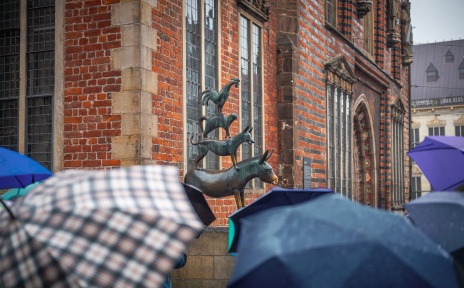
Station 13: Location
You find yourself between the town hall and Our Dear Women's Church, looking at the statue of the Bremen Town Musicians.
Audio length: 03:48 min
Station 13: Transcript
Station 13: The Bremen Town Musicians
You find yourself between the town hall and Our Dear Women's Church, looking at the statue of the Bremen Town Musicians.
This landmark of Bremen is one of the most popular photo motifs for tourists: The Bremen Town Musicians - the fairy tale has made Bremen famous all over the world. Take a moment to look at the bronze sculpture created by sculptor Gerhard Marcks in 1951. Marcks specifically chose the spot on the west side of the town hall for the statue. After the statue was temporarily put up, there were protests as the people of Bremen felt it was too modern and abstract. By the time the work of art was finally installed in 1953, the opposition had died down.
Today, this monument to the Bremen Town Musicians is the most famous of all depictions. Marcks is one of the most important German sculptors of the 20th century. In fact, Bremen dedicated a museum to him during his lifetime in 1971, the Gerhard Marcks Haus.
As early as the twelfth century, the fairy tale of the Town Musicians was in circulation. Later it was written down by the Brothers Grimm and published in the Children's and Household Tales in 1819:
‘...we're going to Bremen, there is something better than death to be found anywhere’ - said the donkey to the rooster and suggested becoming town musicians in Bremen.
Due to their age, the four animals - donkey, dog, cat and rooster - are no longer useful to their owners. Therefore, they are to be killed. But they manage to escape and meet by coincidence. Together they decide to become town musicians in Bremen. So the animals set off together for the Hanseatic city. On the way, they have to stop and spend the night in a forest. There, the four discover a robber's house and drive the robbers away with trickery and loud shouting. As the Bremen Town Musicians like the house so much, they don't want to leave and spend their days there happily ever after.
What message does this fairy tale convey? We believe that the core of the story is that the weak prevail together against the strong.
There is also a historical background. In the 13th century, Bremen allowed merchants to come to the city. This also brought jugglers and musicians. The city council authorised them to play at festivals. And these ‘town musicians’ repeatedly took in travelling artists - just like in the fairy tale.
Now you have a chance to get lucky! Because if you hold the donkey's front legs with both hands, you can make a wish. But be careful! If you only take one hand, one donkey will shake hands with the other, as we say in Bremen. To ensure that your wish comes true, you must not reveal it under any circumstances. For an extra dose of luck, you can also stroke the donkey's nose.
If you still haven't had enough, you can look for other figures of the Town Musicians. You will find them all over Bremen.
We have now reached the end of our audio guide tour on the historic route through Bremen's Old Town.
Thank you very much for your interest. We hope you enjoyed listening.
We trust you will continue to have a pleasant stay in our city. Because there is so much more to discover: the botanika, the Universum, maritime boat trips, art in public spaces and much more.
Haven't had enough yet? Then we recommend our two-hour city tour through the historic city centre. Perhaps a ride on the Stadtmusikantenexpress or our guided tour of the town hall would also be something for you? Find out more at the Bremen Information, at bremen.eu or by calling +49 421 30 800 10.
Complete Download Package
You can also download the audio guide files as a complete .zip file. After unpacking, you can listen to the mp3 files on your smartphone or other devices.